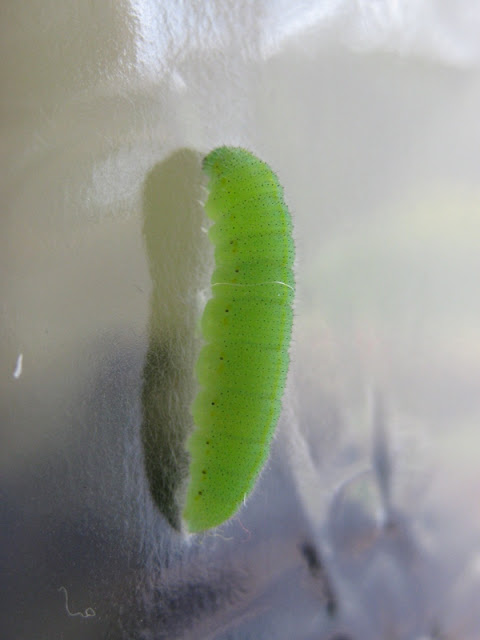On 26th July last year I saw a female Small White laying eggs on some Bittercress outside my study window. As this was in the hen run I went out and lunchtime and dug up the three small plants and put them in a pot.
It circled the garden a couple of times and then landed in an ornamental maple tree. Almost immediately heavy drizzle started to fall and it continued to drizzle for the rest of the day and the following morning. Later that day I found it still in the same spot and it flew off mid-afternoon. So, it spent the first three days of its life waiting for suitable weather to fly!
What I find really interesting is that of the nine chrysalises I had, seven emerged, but the other two remained in the pupal state. I hadn’t been expecting any of them to emerge, as we would normally only expect to have two generations of Small Whites a year here. The seven chrysalises that eclosed formed a third generation of the year.
Fast forward to spring this year and I kept an eye on the two remaining chrysalises. On 3rd May I noticed that they had started to show the colour of the wings. Two days later I spotted a male Small White sitting by its empty chrysalis case. The following day a female Small White emerged from the second chrysalis.

.jpg)



.jpg)
.jpg)
.jpg)
.jpg)
Hello Nick, :=) Thank you for your visit I have been trying to catch up with everyone who
ReplyDeletewished me well, but now I have the most awful back ache so I will revisit you soon to see your post which is always so interesting. See you!
Hi Sonjia, I am so pleased that you are back - well, almost back. I hope you feel better soon and are able to keep posting on your blog.
DeleteHello again,:=) You are my first visit today so I feel OK. What happened was nothing short of miraculous. Perhaps the indoor temperature was warmer than outside, so that the 7 butterflies emerged from their chrysalises, with the right temperature conditions making a third generation possible! A good supply of food and your watchful eye all helped to encourage their development .It does seem strange however that the two that remained only emerged in Spring this year. Were they smaller or weaker than the others? Was the weather unpredictable after the others left. How long can a butterfly go without food. Three days seems a long time to last without food. All I can say is good job Nick, in the first place for seeing the eggs, replanting the Bittercress plants, and observing their development indoors. Suppose you had left them exactly were they were, easily seen from your study window, do you think they would have.survived I doubt it,..those green caterpillars would have been yummy food for so many wild creatures.
ReplyDeleteI really enjoyed your photos and reading all about the experience. Until next time
Take care and all the best.
Thank you Sonjia. So many unknowns! They certainly wouldn't have survived if I had left them, as the Bittercress was growing in the chicken run!! Interestingly a few days ago I saw a Red Admiral laying an egg on a nettle in almost the same location. That is safe inside now!
Delete